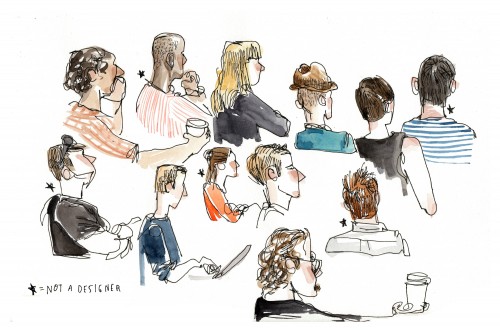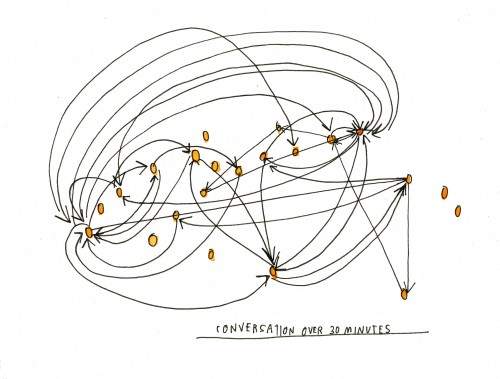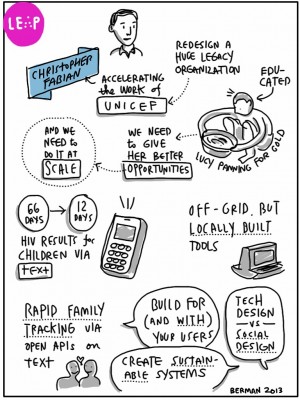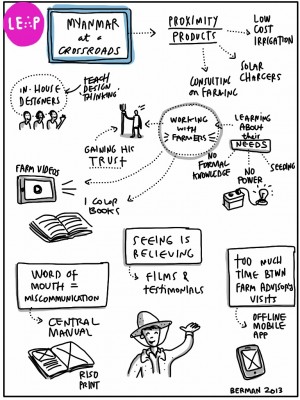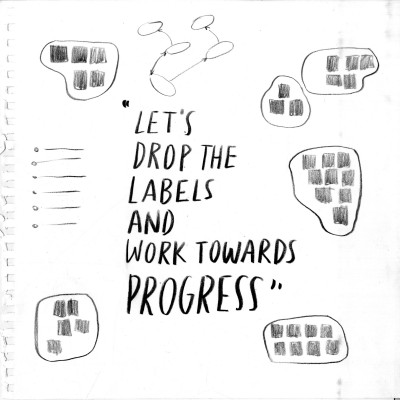Editor’s note: This is the first in our Dotted Line series of three stories from “The New Professional Frontier in Design for Social Innovation: LEAP Symposium,” hosted by Art Center College of Design, Sept. 19–21, 2013.
__
Can design propel social change? If reducing infant mortality risk from HIV in Africa or improving rice crop outcomes among low-income farmers in Asia are any measure, the unequivocal answer—as participants in a three-day immersive symposium at Art Center amply demonstrated—is yes.
Less definitive are answers to the question that prompted the gathering: If I am a designer interested in this kind of work, what kinds of career pathways are available to me?
Organized by the College’s social impact department Designmatters with curatorial contributions from a “braintrust” of pioneers in the rapidly emerging field of design for social innovation, the LEAP Symposium kicked off September 19 at Art Center’s Hillside Campus in Pasadena, giving more than 100 invited participants from across the country an opportunity to examine current professional practices, values and opportunities; share challenges and successes; and envision possibilities for the future.
Why LEAP?
“To leap is not to move timidly, but to advance with great determination,” said Mariana Amatullo, co-founder and Vice President, Designmatters, in her opening remarks in Ahmanson Auditorium. “Design offers an unmapped frontier for social innovation, and the symposium is intended to serve as a platform for creative leaps into that space.”
Amatullo noted that the symposium would be “seeded with probes and what-if scenarios” and that honesty was the most important element of the “genuine conversation and free exchange of ideas” she hoped to foster. She also thanked the many individuals, organizations, companies, networks and foundations that made the LEAP symposium possible, including The National Endowment for the Arts and the Surdna Foundation, along with private sector partners Steelcase, Adobe, Sappi and Autodesk.
She posed three main questions as a point of departure for LEAP: What is design for social innovation? How does it manifest? Why does it matter?
“This is a time when we recognize a sense of urgency for social change to happen—perhaps on a broader scope than ever before—and with it, a call for path-creating forms of collaboration, and generative modes of intervention,” said Amatullo.
Participants, comprised of 60 percent designers and 40 percent non-designers, ranged from leaders at global NGOs and design firms to still-in-school designers directing their education toward social innovation.
Students officially made up 10 percent of participants, but at LEAP, everyone was there to teach, and everyone was there to learn.
Calls for humility, responsibility
“The actual brain trust is all of you, right here in this room,” said Lee Davis, gesturing toward the entire assembly. Davis, scholar-in-residence, Center for Social Design, Maryland Institute College of Art, was the first of five “co-instigators” on the braintrust that Amatullo invited to take the stage, each sharing their vision for the gathering. Sounding themes that would resonate throughout the proceedings, Davis said that designers should not take a passive role but actively document and articulate the value of design practice, and “better train young designers to be bold but humble facilitators embedded in interdisciplinary and collaborative teams.”
William Drenttel, editorial director for Design Observer, noted that through the symposium itself, “we are building a community.” Robert Fabricant, V.P. of Creative, frog, said that designers not only help unlock creativity and empathy, but “we also create a sense of permission so that different questions can be asked. Jocelyn Wyatt, executive director, IDEO.org, reminded the group that, “As designers we have the responsibility to ensure our efforts are first and foremost focused on improving people’s lives.”
Allan Chochinov of the School of the Visual Arts and Core 77 observed that “designers think they’re in the artifact business, but they’re not—they’re in the consequence business. Despite the obvious allure of innovation, it’s not the goal. We need to be humble and to learn from those who’ve been working in social impact.” He went on to share a wide range of reflections and ideas submitted by participants prior to the symposium.
In closing out the first plenary, Art Center Product Design Chair Karen Hofmann remarked that, thanks to programs like Designmatters and other social impact initiatives, the professional mindset was indeed shifting and designers now see themselves not just as makers but as “creative citizens” who co-design in direct collaboration with the communities they wish to serve. “We’re at this tipping point, where we’re really starting to create transformation in society for good,” said Hofmann, who, along with LEAP programming lead Sherry Hoffman, led the expert facilitator team that helped shape working group discussions throughout the symposium.
Room for complexity
Participants dispersed into separate classroom studios for the first of those smaller working group meetings—five groups of about 25 individuals each. There were no official presenters. Instead, people introduced themselves and began to analyze and prioritize some of the ideas shared at the opening, deepening the layers of insight and critique. This participant-led dialogue was supported by Art Center faculty facilitators, student TAs, illustrators, photographers and writers capturing the proceedings in Post-It notes, sketches, mind maps and video testimonials.
“There’s just enough structure,” said one participant with an appreciative nod to LEAP’s organizers. “I’ve been to events that are very rigid. This approach allows for complexity.”
One group spent the morning discussing the principles underlying social innovation design. Does the profession have an express “moral duty” or might concepts like “humility” (“the opposite of an elitist ‘moral’ approach,” said one participant) or “politics” (offered another) be more useful in attempting to define social innovation design?
Someone noted that, in this type of work, the community is the client even though the “contract” and its fulfillment may be less clear. “With my corporate clients we jump jump jump till it’s done. We don’t have that on the social design side. Why is that?” A possible answer came from the other side of the circle: Because measurement of social outcomes must always be negotiated. “Often in commercial innovation the frame and goals are given to you. In social innovation we develop it together.”
In another room, a group that included Art Center department chairs Anne Burdick (Graduate Media Design Practices) and Maggie Hendrie (Interaction Design) attempted to map out emerging career pathways in social impact work. Sami Nerenberg, director of Design for America, was part of that same group and blogged about her experience for Good magazine. “There is no single trajectory,” her team concluded. “It is a constellation of skills, relationships and opportunities that individuals navigate to create a meaningful life practice.” Nerenberg sums up four core skills needed by designers aspiring to create social impact.
Thinking big
Following a communal lunch break at outdoor picnic tables where conversations continued and new acquaintances were made, a panel discussion brought the entire group back together in Ahmanson Auditorium. Art Center Graphic Design faculty member Petrula Vrontikis introduced the panel, “Design Innovation at the Intersection of the Public and Private Sector,” co-programmed with the Toyota Lecture endowed series Art Center Dialogues. Frog’s Robert Fabricant served as moderator.
The two speakers, Bryan Boyer and Chris Fabian, injected a huge dose of optimism into the proceedings by offering concrete examples of what design thinking can achieve on a large scale when it migrates into institutions like national governments and international NGOs.
Boyer, former strategic lead at SITRA (the Finnish Innovation Fund) and project manager of Helsinki Design Lab, was just back in the U.S. after five years in Finland, where he piloted design-led approaches to some of that country’s major social challenges, including aging and climate change. While it may not sound sexy to young designers, he believes that they have a lot to contribute to government bureaucracies. Instead of a traditional, linear “planning” model—Think, Do, Repeat—a design-driven “prototype” model instead sets out to Think, Do, Reinvent, in a constant iterative loop that ultimately achieves greater impact. Although change in a bureaucracy will not happen overnight, said Boyer, gradual shifts in organizational culture can lead to social innovation breakthroughs down the road.
Fabian, co-lead of UNICEF’s innovation team and lead partner for faculty and students in Art Center’s Media Design Practices: Field program, shared compelling examples of design thinking with life-saving impact. For an organization like UNICEF that works in 135 countries, even small, “fractal” changes can make a big difference, he said. For example, by using simple technologies like texting on mobile phones, UNICEF has helped rural clinics in Zambia decrease the average time of getting results for infant HIV tests from 66 days to 12 days. Through a family tracing and reunification system in Haiti and Uganda, lost children are now being reunited with their families in two hours rather than two weeks.
“But technology is just five percent of innovation,” Fabian cautioned. “The best design comes from a whole team,” including, he added, the often “crusty middle” in a large institutional structure.
An afternoon breakout session took people back into their working groups, where discussions became both more focused and more freewheeling. One group generated dozens of what-if scenarios:
“What if all CEOs had MFAs?”
“What if there were a Hippocratic Oath for designers?”
“What if there were a shift in values so that design awards were given not just for making stuff?”
“What if we thought of design like farming? And if we shared resources like a co-op?”
“What if all nonprofits had paid, one-year design internships?”
“What if there were an international student exchange for designers?”
For the day’s final plenary, participants reconvened in the Film Department’s spacious sound stage. Along the way they passed a table where their labors were rewarded with vegetable and fruit juices fresh-blended and served by Art Center’s chef. Lee Davis, who was joined by Karen Hofmann in introducing the wrap-up session, held up his cup of spinach-apple and, with a wide smile, declared it “the best juice I ever had!”
From refreshments, on to recaps: Over the next 45 minutes, representatives of each working group reported on their progress, dwarfed by giant posterboards capturing their collective thinking, all of which would become jumping-off points for the next day of LEAP.
Creating career pathways
As a final treat, Mariana Amatullo introduced three “surprise presenters” not listed on the program, each of whom is successfully charting their own career pathway: upper-term Art Center student Geoff Brewerton and two returning alumni—filmmaker John X. Carey, director of the world’s most watched Internet commercial, and social innovation designer Mariana Prieto, a current IDEO.org Fellow in India.
Brewerton, an international relations major turned graphic designer, recently completed a Designmatters summer fellowship in Myanmar where he worked for a social enterprise called Proximity Designs. The company, whose customers are low-income farmers, locally manufactures irrigation and solar lighting and provides micro-loans and farming advisory services. The experienced farmers on Proximity’s advisory team would go out to meet with younger farmers struggling with low crop yields, said Brewerton, and “they had everything in their heads, but no materials to leave behind.” Because the experts’ instructions were orally transmitted, “it was like the telephone game” and as the information was passed from one farmer to another, inevitably it was no longer accurate. Brewerton worked with the advisory team to develop a series of instructional videos that they scripted and produced on their own, and now share with rural farmers using portable digital devices.
Carey showed two short films: “Illegal,” raising awareness of the challenges faced by undocumented children born in the U.S., and Dove’s “Real Beauty Sketches,” his now-legendary, record-breaking Internet commercial which also carries a social message: Women are more beautiful than they think they are.
Prieto, a Designmatters alumna currently living in India who has led projects addressing water poverty and climate change, among other urgent issues, gave pre-recorded remarks, concluding with a quote from the poet Antonio Machado: “Traveler, there is no path / The path is made by walking.”
Later that evening, at a reception sponsored by Sappi’s Ideas that Matter at the Gamble House, one of Pasadena’s great architectural treasures, Art Center President Lorne M. Buchman welcomed LEAP participants, saluting their efforts and the decade-plus trajectory of Designmatters.
“Our students are in a process of discovery even as they develop solutions,” Buchman said of the growing number of students who have embraced social innovation design. “They understand fundamentally that their creativity finds its meaning by sharing it with others in the world. It’s all about human thriving, not about correcting some deficit, and the role that ‘creative mind’ can have in that process.”
__
Check back again, as our LEAP series continues with coverage of Day 2 and Day 3 .

